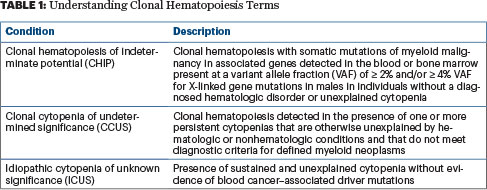The ASCO Post is pleased to present Hematology Expert Review, an ongoing feature that quizzes readers on issues in hematology. In this installment, Syed Ali Abutalib, MD, and L. Jeffrey Medeiros, MD, focuses on clonal hematopoiesis of indeterminate potential (also referred to as CHIP) as well as risk factors for its development. For each quiz question that follows, select the one best answer. The correct answers and accompanying discussions appear below.
GUEST EDITORS

Syed Ali Abutalib, MD

L. Jeffrey Medeiros, MD
Dr. Abutalib is Director of the Hematologic Malignancies, Hematopoietic Stem Cell Transplantation & Cellular Therapy Programs at the Advocate/Aurora St. Luke’s Medical Center, Milwaukee, and Associate Professor at Rosalind Franklin University of Medicine and Science, Chicago. Dr. Medeiros is Professor and Chair, Department of Hematopathology, The University of Texas MD Anderson Cancer Center, Houston.
Introduction
Clonal hematopoiesis in the context of aging refers to the presence of a clonal population of hematopoietic cells derived from a mutated multipotent stem or progenitor cell that confers a selective proliferative advantage. Clonal hematopoiesis of indeterminate potential (CHIP) occurs in individuals without unexplained cytopenias, hematologic malignancies, or other clonal disorders.1 Analysis of sequencing data from more than 30,000 individuals has identified CHIP as a prevalent, age-related phenomenon in otherwise healthy individuals. Of note, CHIP is associated with an elevated risk of hematologic cancers, cardiovascular disease, and all-cause mortality.2-8 Clonal hematopoiesis detected in individuals with unexplained cytopenia is referred to as clonal cytopenia of undetermined significance (CCUS) and confers a significant risk of progression to hematologic cancers.1
Question 1
Which of the following statements best describes clonal hematopoiesis of indeterminate potential (CHIP)?
A. It is detected in persons with unexplained cytopenia(s), in the absence of clonality.
B. It is detected in individuals with unexplained cytopenia.
C. It is detected in otherwise-healthy individuals.
D. All of the above
Question 2
Besides aging, which of the following are risk factors for the development of CHIP?
A. Smoking
B. Loss of chromosome Y
C. Male gender
D. All of the above
E. A and C
Question 3
Which of the following statements about CHIP is correct?
A. It affects 20% of individuals younger than age 40.
B. CHIP-associated mutations are most commonly base substitutions or small insertions/deletions.
C. CHIP-associated mutations are limited to DNMT3A, TET2, and ASXL1.
D. All of the above
Question 4
Which of the following conditions may be associated with CHIP?
A. Atherosclerotic cardiovascular disease
B. Thromboembolic events
C. Inflammation
D. Stroke
E. Lung cancer
F. All of the above
Question 5
Which of the following statements about clonal cytopenias of undetermined significance (CCUS) is correct?
A. The risk of progression from CCUS to a frank myeloid neoplasm is lower in individuals with an SF3B1 mutation compared with those harboring other mutations.
B. Approximately 5% of people with one or more cytopenias will have a mutation identified in a driver gene or a chromosomal abnormality, meeting the criteria for CCUS.
C. The risk of progression from CCUS to a frank myeloid neoplasm is independent of the size of the clonal population.
D. Patients with clonal cytopenia have a significantly higher risk of developing a myeloid neoplasm than those with no evidence of clonality.
Answers to Hematology Expert Review Questions
Question 1
Which of the following statements best describes clonal hematopoiesis of indeterminate potential (CHIP)?
Correct answer: C. It is detected in otherwise-healthy individuals.
Expert Perspective
The term clonal hematopoiesis of indeterminate potential (CHIP) refers to the presence of somatic mutations commonly associated with myeloid malignancies in otherwise-asymptomatic individuals who do not exhibit unexplained cytopenias or meet diagnostic criteria for a myeloid neoplasm.1 A variant allele fraction threshold of ≥ 2% (or ≥ 4% for X-linked mutations in males) is commonly used to define CHIP. In contrast, individuals with clonal hematopoiesis and unexplained cytopenias are classified as having clonal cytopenia of undetermined significance (CCUS), a condition with a notable risk of progression to overt hematologic malignancy. Persistent, unexplained cytopenias in the absence of clonal markers are categorized as idiopathic cytopenia of undetermined significance (ICUS). As research continues to evolve, these definitions are expected to be refined (see Table 1).
Question 2
Besides aging, which of the following are risk factors for the development of CHIP?
Correct answer: E. A and C.
Expert Perspective
Although aging remains the most significant risk factor for the development of CHIP, additional contributors include smoking, male gender, prior exposure to cytotoxic therapies, and underlying conditions such as aplastic anemia. Certain inherited germline variants may also predispose individuals to CHIP. Of note, Hispanic ancestry appears to confer a reduced risk. Although cytogenetic studies such as fluorescence in situ hybridization and karyotyping are seldom performed in individuals with normal blood cell counts, incidental findings—such as mosaic loss of chromosome Y—may point to underlying CHIP.
Question 3
Which of the following statements about CHIP is correct?
Correct answer: B. CHIP-associated mutations are most commonly base substitutions or small insertions/deletions.
Expert Perspective
CHIP is relatively rare in individuals younger than age 40 years, but its prevalence increases markedly with age, affecting approximately 10% to 40% of older adults. The mutations underlying CHIP typically consist of single nucleotide variants or small insertions/deletions.1 However, larger structural alterations, such as acquired chromosomal mosaicism, are being increasingly recognized. Although the most frequently implicated genes in CHIP are DNMT3A, TET2, and ASXL1, more than 50 genes have been associated with the condition, indicating a broader mutational spectrum than previously appreciated.1
Question 4
Which of the following conditions may be associated with CHIP?
Correct answer: F. All of the above.
Expert Perspective
Compared with age-matched individuals without CHIP, those with CHIP demonstrate a higher risk of all-cause mortality and various nonmalignant diseases.2-9 They include atherosclerotic cardiovascular disease, thromboembolic complications, stroke, systemic inflammation, and even certain solid tumors such as lung cancer.6 The heightened risk is believed to result from altered immune cell behavior and chronic inflammation driven by CHIP-associated mutations. For instance, JAK2 mutations have been linked to thromboembolic events and an elevated risk of ischemic stroke.7 Similarly, TET2 and DNMT3A mutations contribute to inflammatory pathways that may underlie both cardiovascular disease and cerebrovascular events.8 CHIP represents a paradigm shift in understanding age-related risk factors, linking somatic mutations in blood cells to systemic inflammation and an increased predisposition to vascular diseases, thereby opening new avenues for early detection and targeted intervention.
Question 5
Which of the following statements about clonal cytopenias of undetermined significance (CCUS) is correct?
Correct answer: D. Patients with clonal cytopenia have a significantly higher risk of developing a myeloid neoplasm than those with no evidence of clonality.
Expert Perspective
The risk of progression from CCUS to a frank myeloid neoplasm increases with the following factors:
- The size of the clonal population (ie, variant allele fraction);
- The presence of multiple mutations or high-risk gene mutations (eg, TP53, PPM1D, JAK2, RUNX1, SF3B1, SRSF2, U2AF1, IDH2, and IDH1);
- The number and severity of cytopenias;
- A history of exposure to cytotoxic therapy.
Approximately 30% of individuals with one or more cytopenias have a mutation in a driver gene or a chromosomal abnormality consistent with CCUS. Patients with clonal cytopenia carry a significantly higher risk of developing a myeloid neoplasm compared with those without clonality (ie, idiopathic cytopenias of unknown significance, see Table 1).

DISCLOSURE: Dr. Abutalib has served on the advisory board of AstraZeneca. Dr. Medeiros reported no conflicts of interest.
REFERENCES
- Khoury JD, Solary E, Abla O, eds: World Health Organization Classification of Haematolymphoid Tumours: Myeloid Proliferations and Neoplasms, 5th ed, pp 12-19. Lyon, France; International Agency for Research on Cancer; 2024.
- Jaiswal S, Natarajan P, Silver AJ, et al: Clonal hematopoiesis and risk of atherosclerotic cardiovascular disease. N Engl J Med 377:111-121, 2017.
- Genovese G, Kähler AK, Handsaker RE, et al: Clonal hematopoiesis and blood-cancer risk inferred from blood DNA sequence. N Engl J Med 371:2477-2487, 2014.
- Zon RL, Sekar A, Clapham K, et al: JAK2-mutant clonal hematopoiesis is associated with venous thromboembolism. Blood 144:2149-2154, 2024.
- Weeks LD, Ebert BL: Causes and consequences of clonal hematopoiesis. Blood 142:2235-2246, 2023.
- Tian R, Wiley B, Liu J, et al: Clonal hematopoiesis and risk of incident lung cancer. J Clin Oncol 41:1423-1433, 2023.
- Kristiansen MH, Kjaer L, Skov V, et al: JAK2V617F mutation is highly prevalent in patients with ischemic stroke: A case-control study. Blood Adv 7:5825-5834, 2023.
- Cobo I, Tanaka T, Glass CK, et al: Clonal hematopoiesis driven by DNMT3A and TET2 mutations: Role in monocyte and macrophage biology and atherosclerotic cardiovascular disease. Curr Opin Hematol 29:1-7, 2021.
- Malcovati L, Gallì A, Travaglino E, et al: Clinical significance of somatic mutation in unexplained blood cytopenia. Blood 129:3371-3378, 2017.

